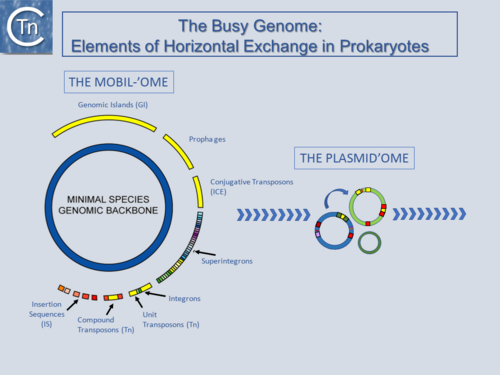General Information/Overview
|
Intracellular MGE or transposable elements (TE) include transposons (Tn) and insertion sequences (IS) but can embrace integrons (In) [3][4] and introns [5][6][7]. Originally Tn were distinguished from IS since they carry passenger (also called cargo) genes not involved in catalyzing or regulating TE movement. Most eukaryotic DNA transposons have relatives among the prokaryotic IS (see [8]) and it is not surprising that a variety of these elements carrying passenger genes are now also being identified [9][10]. Prokaryotes harbor a host of such elements as well as several types of structure possessing characteristics of both groups (e.g. Integrative Conjugative Elements, ICE, originally called conjugative transposons, as well as other types of non-conjunctive genomic islands) [11][12][13].
|
 Fig.1.1.1. The Busy Genome: Elements of Horizontal Exchange. The genome backbone, which includes housekeeping genes, is shown as the inner circle (blue). The "mobilome" is shown in the outer circle. This includes a number of different types of MGE both intercellular (some genomic islands, prophages, and conjugative transposons) and intracellular (Insertion sequences, compound and unit transposons, integrons, and super integrons). An important class of intercellular MGE, the plasmids, act as transposon vectors and facilitate TE movement within the plasmidome. |
Bibliography
- ↑ </nowiki>
- ↑ </nowiki>
- ↑ Escudero JA, Loot C, Nivina A, Mazel D . The Integron: Adaptation On Demand. - Microbiol Spectr: 2015 Apr, 3(2);MDNA3-0019-2014 [PubMed:26104695] [DOI] </nowiki>
- ↑ </nowiki>
- ↑ </nowiki>
- ↑ </nowiki>
- ↑ </nowiki>
- ↑ </nowiki>
- ↑ Bao W, Jurka MG, Kapitonov VV, Jurka J . New superfamilies of eukaryotic DNA transposons and their internal divisions. - Mol Biol Evol: 2009 May, 26(5);983-93 [PubMed:19174482] [DOI] </nowiki>
- ↑ </nowiki>
- ↑ Burrus V, Waldor MK . Shaping bacterial genomes with integrative and conjugative elements. - Res Microbiol: 2004 Jun, 155(5);376-86 [PubMed:15207870] [DOI] </nowiki>
- ↑ </nowiki>
- ↑ Guérillot R, Da Cunha V, Sauvage E, Bouchier C, Glaser P . Modular evolution of TnGBSs, a new family of integrative and conjugative elements associating insertion sequence transposition, plasmid replication, and conjugation for their spreading. - J Bacteriol: 2013 May, 195(9);1979-90 [PubMed:23435978] [DOI] </nowiki>